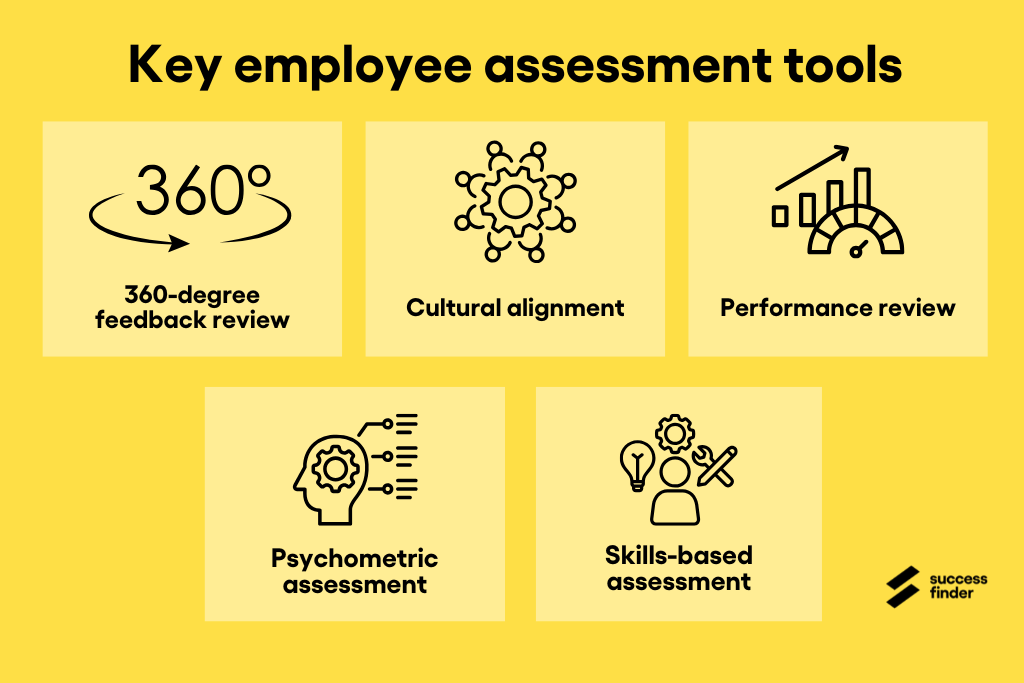Employee assessment is not just an HR process, it’s a strategic tool that enables more informed and objective talent decisions. By identifying strengths, potential and development areas, organizations can ensure their teams perform at their highest level, in alignment with business goals.
But what makes an employee assessment truly effective? How can organizations use these insights to not only evaluate, but also drive growth?
What is employee assessment?
Rather than focusing solely on past performances, an employee assessment evaluates an individual’s competencies and potential, providing a fuller picture.
By analyzing a combination of behavioral traits and competencies, effective employee assessments help HR teams make more informed decisions about talent selection, succession planning, leadership development, and internal mobility.
It is also a way to ensure employees are aligned with business objectives, clarify expectations and foster a culture of continual growth.
How to assess employees: moving beyond instinct
To truly unlock employee potential, HR professionals need to leverage evaluation methods that go beyond subjective opinions.

Key employee assessment tools
360-degree feedback review
This method provides a holistic perspective on an employee’s strengths and development areas by collecting feedback from multiple sources: managers, peers, direct reports, additionally to self-assessment.
It enhances self-awareness by giving employees more insights into their own interpersonal and leadership skills, and how these impact their performance and effectiveness. The multiplicity of stakeholders minimizes biases and makes it a reliable method.
However, the process can be cumbersome and time-consuming due to the number of participants involved, complex methodology, and the logistical effort it requires to analyze responses.
Psychometric assessments
They are scientifically validated and reliable tools that measure an individual’s core traits, including behavioral preferences and leadership potential.
They provide deeper insights into problem-solving styles, adaptability, work preferences, leadership orientations, and motivations as well as how individuals respond to challenges.
Psychometric assessments can also help identify employees’ potential for future roles and whether their skills align with long-term business needs. They can be integrated into a 360-degree evaluation as part of the self-assessment process.
Skills-based evaluations
These assessments focus on hands-on tasks or job simulations that evaluate hard skills and technical expertise relevant to a role. They often require a digital platform or sandbox environment where employees can practice and be evaluated.
While these assessments provide fair and transparent results, they don’t necessarily cover soft skills, which are essential at all levels of an organization.
Cultural alignment assessments
They help determine whether an employee’s work style, behaviors, and motivations align with the company’s culture, business goals and long-term vision. It can be done through surveys, focus groups, meetings, or psychometric assessments.
Ensuring cultural alignment helps employees feel more connected to the organization and contribute meaningfully to its success.
Performance review
It is a formal assessment conducted with a manager to evaluate how well an employee is performing in their role. It provides an opportunity to address concerns, clarify expectations and plan for career progression.
Most performance reviews are documented and shared with HR. However, relying solely on past performance to assess potential can be misleading, as a high-performing individual in one role may not necessarily thrive in another without the right behavioral traits and leadership skills.
The business impact of employee assessment
Improving talent selection and succession planning
A structured employee assessment process helps organizations select, retain, and develop the right people for critical roles. It leads to:
- Better talent selection – Identifying candidates and employees with the right competencies, behaviors, and potential to excel in a role.
- High-potential (HiPo) identification – Pinpointing employees with leadership potential early, ensuring the organization invests in future leaders.
- Succession planning – Building a strong pipeline of leaders ready to step into key roles to reduce disruption and ensure business continuity.
By aligning assessment data with business objectives, organizations can ensure they have the right talent in place to sustain and accelerate growth.
Developing employees strategically
To stay competitive and engage their people, organizations must develop employees in ways that align with both individual potential and business needs. Employee assessments provide valuable insights into skills gaps, strengths, and development opportunities in the context of their employment, leading to:
- Personalized development plans – Customizing learning experiences beyond a one-size-fits-all approach to fit employees’ unique abilities and growth potential.
- Targeted upskilling and reskilling – Identifying critical skill gaps and providing necessary training to keep the workforce agile.
- Data-backed career pathing – Helping employees visualize clear, structured career growth opportunities based on their potential and aspirations.
Enhancing employee engagement and retention
Employees who feel valued, supported, stimulated and see a clear path for growth are more likely to stay and thrive. It reduces turnover and improves overall workplace trust. Employee assessments contribute to engagement and retention by:
- Providing meaningful feedback – Empowering employees with deeper self-awareness through clear understanding of their strengths, areas for improvement they need to put more on, and how they contribute to the company’s success.
- Encouraging ownership over one’s personal development – When employees see that assessments lead to personalized growth opportunities, they take greater responsibility for their progress.
- Fostering a culture of transparency and fairness – Objective assessment data reduces biases in selection, development opportunities and career progression, increasing trust in the organization.
Conclusion
The future of HR is data-driven, personalized, and strategic.
Organizations that leverage employee assessments strategically don’t just optimize selection and development—they create high-performance cultures where employees thrive, leaders emerge, and business goals are met.
By using assessment data to drive decision-making, businesses gain a competitive edge in succession planning, talent development, and employee engagement, ultimately unlocking their full growth potential.
Ready to transform your talent strategy with data-driven insights?
Discover how SuccessFinder’s psychometric assessment can help your organization thrive.




